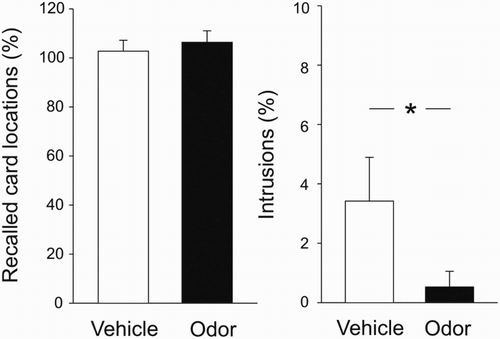Figures & data
Figure 1. Experimental procedure. Each subject participated in two conditions – odour and vehicle – in a counterbalanced order. Participants learned a 2D object location task (interference memory task) on Day 1 in the presence of an odour. On Day 2, 24 h later, participants learned a similar 2D object location task with the same card pairs but the second card of each pair being presented at a different location (target memory task). Learning of the target memory task took place without odour. Following learning of the target memory task, participants were allowed to sleep for ∼40 min and received either odour stimulation (in the odour condition) or a vehicle (in the vehicle condition) for ∼20 min during SWS. After being awakened, participants were tested on their recall of the target memory task first, followed by a recall test of the interference memory task. Both retrieval tests took place without odour presentation.

Figure 2. Performance on the target memory task after reactivation of the interference memory task during sleep. Recall performance (left) is indicated as per cent of correctly recalled card locations at retrieval relative to learning performance. The odour and vehicle conditions did not differ significantly. Intrusions (right) are indicated as per cent of card locations from the interference memory task falsely indicated during recall of the target memory task, relative to learning of the interference memory task. Participants displayed fewer intrusions following odour presentation compared to vehicle.* p < .05.

